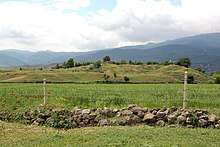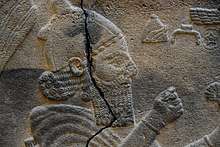Sam'al
Sam'al (Zincirli Höyük) was founded at least as far back as the Early Bronze Age. It was largely abandoned during the Hittite and Mittani periods then flourished again in the Iron Age, initially under Luwian speaking Neo-Hittites, and by the 920 BC had become a kingdom. In the 9th and 8th century BC it came under control of the Neo-Assyrian Empire and by the 7th century BC it had become a directly ruled Assyrian province. It is located in the Anti-Taurus Mountains of modern Turkey's Gaziantep Province.
 Archeological site of Sam'al | |
 Shown within Turkey | |
| Location | Zincirli Höyük, Gaziantep Province, Turkey |
|---|---|
| Coordinates | 37°06′13″N 36°40′43″E |
| Type | Settlement |
| Site notes | |
| Condition | In ruins |
History

The site of Sam'al was occupied in the Early Bronze Age, and is thought to be part of the kingdom of Yamhad (Aleppo) early in the second millennium. It was then abandoned but later rose again in the Iron Age, eventually becoming a kingdom. With the rise of the Neo-Assyrian Empire, Sam'al became a vassal state and later a province of that empire.
Kingdom of Sam'al
Kingdom of Sam'al | |||||||||||
|---|---|---|---|---|---|---|---|---|---|---|---|
| 1200 BC–609 BC | |||||||||||
| Status | Principality/Kingdom | ||||||||||
| Capital | Sam'al | ||||||||||
| Common languages | Hittite Samalian Akkadian | ||||||||||
| History | |||||||||||
• Established | 1200 BC | ||||||||||
• Disestablished | 609 BC | ||||||||||
| |||||||||||
Kingdom of Sam'al (in Samalian Yādiya, in Aramaic Ya'udi) was a middle power of the Middle-East in the first half of the 1st millennium BCE. It was near the Nur Mountains. Sam'al was the capital of the country. Royal steles and stone tablets from the period, of Kilamuwa and Panamuwa II, are the main sources for historical data about this timeperiod.

It became a middle power at the end of the 10th century BCE. It had expanded from being a city state and gained territories from Carchemish, around Adana from Quwê and remained independent. It didn't become part of Cilicia. In 859 BC Alimus was saved with the help of Hayyanu, king of Sam'al. He didn't participate in the Battle of Qarqar in 853 BC, but Assyria had been blocked in the Western area. Though the campaign of Assyria in 825 BC occupied the vital territories of Sam'al, Quwê had been defeated, but it had been reorganised as Denyen. After the death of Shalmaneser III, Ya'udi again became independent.
Some rulers of Sam'al had aggressive expansionist politics; others acceded to one of the anti-Assyrian Syrian coalition. Assyrian sources are not clear regarding Sam'al. Ya'udi was one of Assyria's satellite states in the annals of Shalmaneser III. Though around 830 BC Azitawadda, king of Denyen, states Ya'udi is his satellite country – at the same time, Kilamuwa mentions on his stela that he hired Assyria against Denyen. Other sources from the same period mention Ya'udi as a satellite state of Denyen and Assyria wanted to occupy this territory. Kilamuva might offer for Deyen to be a satellite state. Before this, he should defeat his greatest foe, Azitawadda. Assyrians won over Denyen and Sam'al in 825 BC. Sam'al became independent after the death of Shalmaneser III.
There is an alternative opinion which states that Ya'udi and Sam'al were originally separate royal houses and Sam'al, the younger of the two, fought against the Assyrians at Alimus in 859 BC, in 858 BC when Shalmanser III crossed the Euphrates for the first time, and again in 853 BC at the Battle of Qarqar. The Kingdom of Sam'al was founded by Hayyanu and his successor was Ahabbu of Siri'laya (Zincirli) in 854 BC. Whereas Gabar, the founder of Ya'udi, and his successors became a member of the Assyrian satellites. This makes clear why Shalmaneser III lists Ya'udi (Bit-Gabbari) but not Sam'al as a satellite state. The Kingdom of Ya'udi wanted to open a corridor between Assyria and Denyen. It was prevented by the unified Syrian forces. This unity had been dissolved in 825 BC. After the death of Shalmanezer III Denyen couldn't occupy it but the Samalians could. Sam'al annexed Ya'udi and moved into the palace of Kilamuva.
At the end, in 717 BC, Assyria occupied the country under the rule of Sargon II.
Archaeology
The site was excavated in 1888, 1890, 1891, 1894 and 1902 during expeditions led by Felix von Luschan and Robert Koldewey.[1][2][3][4][5] Each of the expeditions was supported by the German Orient Committee, except for the fourth (1894), which was financed with monies from the Rudolf-Virchow-Stiftung and private donors.[6]
They found a heavily fortified teardrop-shaped citadel, which was surrounded by the as yet unexcavated town and a further enormous double fortification wall with three gates and 100 bastions. Among the notable objects found at the site are five giant statues of lions carved from stone, which apparently had guarded the gates of the city, but may have been ritually buried together within the citadel. The German excavations on the citadel recovered large numbers of relief-carved orthostats, along with inscriptions in Aramaic, Phoenician, and Akkadian. These are on exhibit in the Pergamon Museum, Berlin, and Istanbul. Also found was the notable Victory stele of Esarhaddon celebrating his victory over Taharqa. The field diaries of the excavation were lost during World War II.
In August 2006, the Oriental Institute of the University of Chicago began a new long-term excavation project at the site of Zincirli under the directorship of David Schloen. Seven seasons of excavation have been conducted through 2012.[7] [8]
Inscriptions
Three royal inscriptions from Ya'udi or Sam'al are particularly informative for the history of the area. The earliest is from the reign of King Panammu I, the others later at 730 BCE. Their language is known as Samalian or Ya'udic. Some scholars including P.-E. Dion.[9] and S. Moscati[10] have advanced Samalian as a distinct variety of Old Aramaic.[11][12][13] Attempts to establish a rigorous definition of "Aramaic" have led to a conclusion of Samalian as distinct from Aramaic, despite some shared features.[14][15][16]
The stele of Kuttamuwa
Kuttamuwa was an 8th-century BC royal official from Sam'al who ordered an inscribed stele, that was to be erected upon his death. The inscription requested that his mourners commemorate his life and his afterlife with feasts "for my soul that is in this stele." It is one of the earliest references in a Near East culture to a soul as a separate entity from the body. The 800-pound basalt stele is three feet tall and two feet wide.[17]
Notes
- Felix von Luschan et al, Ausgrabungen in Sendschirli. vol. 1: Einleitung und Inschriften, Spemann, 1893
- Felix von Luschan and Carl Humann and Robert Koldewey, Ausgrabungen in Sendschirli. vol. 2: Ausgrabungsbericht und Architektur, Spemann, 1898
- Felix von Luschan, Ausgrabungen in Sendschirli. vol. 3: Thorsculpturen, Georg Reimer, 1902
- Felix von Luschan and Gustav Jacoby, Ausgrabungen in Sendschirli. vol. 4: Georg Reimer, 1911
- Felix von Luschan and Walter Andrae, Ausgrabungen in Sendschirli. vol. 5: Die Kleinfunde von Sendschirli, Walter de Gruyter, 1943
- Felix von Luschan, "Ueber einige Ergebnisse der fünften Expedition nach Sendschirli," Zeitschrift für Ethnologie 34 (1902): 379–80.
- J. David Schloen and Amir S. Fink, New Excavations at Zincirli Höyük in Turkey (Ancient Sam'al) and the Discovery of an Inscribed Mortuary Stele, Bulletin of the American Schools of Oriental Research, vol. 356, pp. 1-13, November 2009
- Schloen, J David; Fink, Amir S., SEARCHING FOR ANCIENT SAM'AL: NEW EXCAVATIONS AT ZINCIRLI IN TURKEY, Near Eastern Archaeology, Vol. 72, Iss. 4, pp. 203-219, 2009
- P.-E. Dion, La langue de Ya'udi (Waterloo, Ontario 1974), in: RSO 53 (1979)
- Moscati 1964, S.—: An Introduction to the Comparative Grammar of the Semitic Languages, Harrassowitz, Wiesbaden.
- Klaus Beyer The Aramaic Language, Its Distribution and Subdivisions 1986- Page 12 3525535732 "In addition the three "Ya'udic" royal inscriptions from Zinjirli in northern Syria (c. 825, 750, 730 B.C.) witness to early Ancient Aramaic: KAl 25, 214, 215; TSSI -, 13, 14; J.Friedrich, Phoni- zisch-punische Grammatik, Rome 1951, 153-162; ..."
- Angel Sáenz-Badillos, John Elwolde A History of the Hebrew Language 1996 0521556341 Page 35 "According to some scholars, after 1400 BCE the languages which would later develop into Ya'udic and Aramaic...."
- Joseph A. Fitzmyer A Wandering Armenian: Collected Aramaic Essays 1979 - Page 68 080284846X "This is partly because he refuses to see Ugaritic as Canaanite and partly because he prefers to treat so-called Ya^udic as distinct from Aramaic — if I understand him correctly.89 "
- Huehnergard, John (1995). "What is Aramaic?". Aram (7). pp. 261–282.
- Kogan, Leonid (2015). Geneological Classification of Semitic. de Gruyter.
- Pat-El, Na'ama; Wilson-Wright, Aren (2019). "The subgrouping of Samalian: Arguments in favor of an independent branch". Maarav. 23 (2): 371–387.
- "Found: An Ancient Monument to the Soul". New York Times. November 17, 2008. Retrieved 2008-11-18.
In a mountainous kingdom in what is now southeastern Turkey, there lived in the 8th century BC. a royal official, Kuttamuwa, who oversaw the completion of an inscribed stone monument, or stele, to be erected upon his death. The words instructed mourners to commemorate his life and afterlife with feasts "for my soul that is in this stele."
See also
- Cities of the ancient Near East
- Short chronology timeline
References
- Simon B. Parker (1996). "Appeals for military intervention: stories from Zinjirli and the Bible". The Biblical Archaeologist 59(4): 213-224.
- Ussishkin, David (1970). "The Syro-Hittite ritual burial of monuments". Journal of Near Eastern Studies 29(2): 124-128.
- Ralf-B Wartke, Sam'al: Ein aramäischer Stadtstaat des 10. bis 8. Jhs. v. Chr. und die Geschichte seiner Erforschung, Philipp von Zabern, 2005
- J. P. Francev, ed. (1967). Világtörténet tíz kötetben, I. kötet (in Hungarian). Kossuth K.
- U. Bahadir. Alkim, The Road from Samal to Asitawandawa: Contributions to the Historical Geography of the Amanus Region, Anadolu Arastirmalari, vol. 2, pp. 3–41, 1965
- Dennis Pardee, A New Aramaic Inscription from Zincirli, Bulletin of the American Schools of Oriental Research, vol. 356, pp. 51–71, 2009
- David Schloen, J. and Amir S. Fink, Searching for Ancient Samal: New Excavations at Zincirli in Turkey, Near Eastern Archaeology, vol. 72/4, pp. 203–219, 2009
- Eudora J. Struble and Virginia Rimmer Herrmann, An Eternal Feast at Sam?al: The New Iron Age Mortuary Stele from Zincirli in Context, Bulletin of the American Schools of Oriental Research, vol. 356, pp. 15–49, 2009
- VR Herrmann, Urban organization under empire: Iron Age Sam’al (Zincirli, Turkey) from royal to provincial capital, Levant, vol. 49 (3), pp. 284–311, 2017
External links
| Wikimedia Commons has media related to Sam'al. |